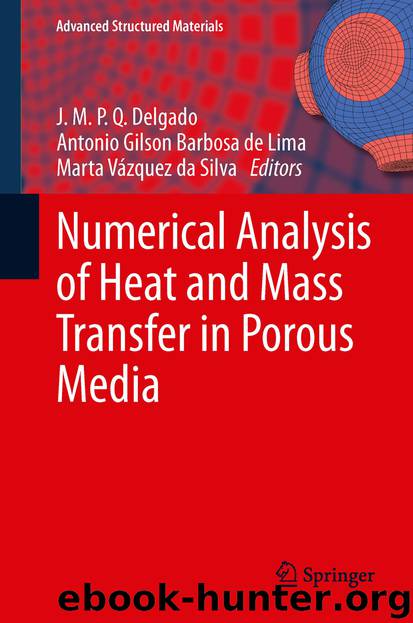Numerical Analysis of Heat and Mass Transfer in Porous Media by J. M. P. Q. Delgado Antonio Gilson Barbosa Lima & Marta Vázquez Silva

Author:J. M. P. Q. Delgado, Antonio Gilson Barbosa Lima & Marta Vázquez Silva
Language: eng
Format: epub
Publisher: Springer Berlin Heidelberg, Berlin, Heidelberg
Keywords
Porous mediaThermal dispersionConvective heat transferCylinder arrayGraphite foam
1 Introduction
Transport in high-conductivity porous media, such as metal foams, is of practical importance in heat transfer applications including compact heat sinks and heat exchangers [1–8]. While the effectiveness of high-conductivity porous materials as enhanced heat transfer materials has been shown, there are significant challenges involved in simulating the flow and thermal performance of devices incorporating these materials. Since there are generally thousands of pores contained within a given domain of interest, it is impractical to compute the pore-level fields directly. Thus, the method of volume-averaging [9, 10] is typically employed to derive transport equations governing the averaged flow and thermal fields. The challenge with averaging methods, however, is that pore-level terms remain in the governing equations and must be properly characterized by effective properties to produce a closed set of equations.
One particular effective property that has been the topic of considerable research is the thermal dispersion conductivity, which arises from volume-averaging the convection term in the energy equation for the fluid phase. From a physical perspective, thermal dispersion describes the apparent enhancement in conduction within the fluid phase, resulting from pore-level mixing, when the flow is viewed in an averaged sense. When considering fluid and solid constituents with similar thermal properties, the two constituents can be assumed to be in local thermal equilibrium with one another and a single energy equation can be used for the two phases combined. In this case, the effective thermal conductivity, which takes into account dispersion and tortuosity effects, is the only effective property required for closure of the energy equation. Since porous media literature has historically been focused on low-conductivity media where the local thermal equilibrium assumption is valid, most work on the closure of volume-averaged equations has been focused on determining the effective thermal conductivity. Furthermore, since dispersion effects typically dominate tortuosity effects at moderate Péclet numbers ( where is the Reynolds number and is the Prandtl number), most efforts have been directed towards the dispersion term.
Dispersion was first studied by Taylor [11] and Aris [12] for a chemical species flowing in a tube. These studies showed that the flowing species is dispersed relative to a plane moving at the mean flow speed with an apparent axial diffusivity equal to the molecular diffusivity plus the dispersion diffusivity, which is proportional to the square of the Péclet number. While this is strictly only valid for flow in a tube, similar Péclet number dependencies have been observed and/or assumed in many other cases of significantly different geometry. Since dispersion depends on local mixing, any results obtained are particular to the flow configuration for which they are derived. To this end, many experimental and analytical studies have been undertaken to explore dispersion in other porous media such as packed beds of particles. For example, Yagi et al. [13] found that the axial dispersion conductivity depends linearly on for packed beds of particles. A similar relationship was observed by Hunt and Tien [14] for fibrous porous materials.
More recently, numerical studies have been used to investigate thermal dispersion in porous media.
Download
This site does not store any files on its server. We only index and link to content provided by other sites. Please contact the content providers to delete copyright contents if any and email us, we'll remove relevant links or contents immediately.
| Automotive | Engineering |
| Transportation |
Whiskies Galore by Ian Buxton(41727)
Introduction to Aircraft Design (Cambridge Aerospace Series) by John P. Fielding(33022)
Small Unmanned Fixed-wing Aircraft Design by Andrew J. Keane Andras Sobester James P. Scanlan & András Sóbester & James P. Scanlan(32693)
Craft Beer for the Homebrewer by Michael Agnew(18087)
Turbulence by E. J. Noyes(7902)
The Complete Stick Figure Physics Tutorials by Allen Sarah(7273)
Kaplan MCAT General Chemistry Review by Kaplan(6831)
The Thirst by Nesbo Jo(6770)
Bad Blood by John Carreyrou(6483)
Modelling of Convective Heat and Mass Transfer in Rotating Flows by Igor V. Shevchuk(6359)
Learning SQL by Alan Beaulieu(6169)
Weapons of Math Destruction by Cathy O'Neil(6090)
Man-made Catastrophes and Risk Information Concealment by Dmitry Chernov & Didier Sornette(5883)
Digital Minimalism by Cal Newport;(5593)
Life 3.0: Being Human in the Age of Artificial Intelligence by Tegmark Max(5410)
iGen by Jean M. Twenge(5334)
Secrets of Antigravity Propulsion: Tesla, UFOs, and Classified Aerospace Technology by Ph.D. Paul A. Laviolette(5245)
Design of Trajectory Optimization Approach for Space Maneuver Vehicle Skip Entry Problems by Runqi Chai & Al Savvaris & Antonios Tsourdos & Senchun Chai(4962)
Electronic Devices & Circuits by Jacob Millman & Christos C. Halkias(4872)
